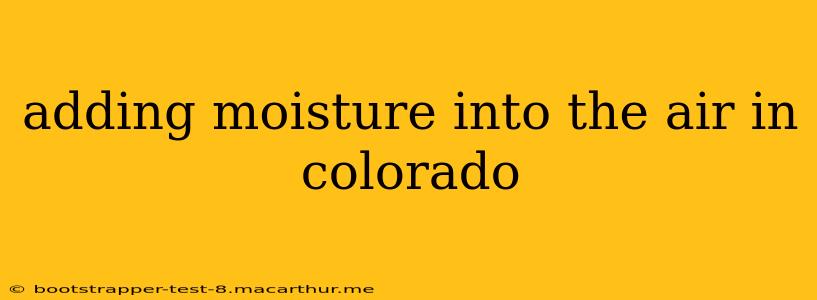Colorado's famously dry climate, while offering stunning scenery and abundant sunshine, presents a unique challenge: maintaining comfortable humidity levels indoors, especially during the long, arid winters. Dry air can lead to a host of problems, from irritated skin and respiratory issues to damaged wood furniture and static electricity. This comprehensive guide explores effective methods for adding moisture to the air in your Colorado home, addressing common concerns and offering practical solutions.
Why is Adding Moisture Important in Colorado?
Colorado's low humidity is a result of its high altitude and geographical location. The lack of moisture can significantly impact your health and well-being. Dry air irritates mucous membranes, leading to dry noses, throats, and coughs. It can exacerbate conditions like asthma and allergies. Furthermore, low humidity can damage wooden furniture and flooring, causing them to crack and warp. Finally, the static electricity generated by dry air can be incredibly annoying.
What are the Best Ways to Add Moisture to the Air in Colorado?
Several effective strategies can help combat Colorado's dry air. The best approach depends on your budget, home size, and personal preferences.
1. Humidifiers: Your Primary Weapon Against Dry Air
Humidifiers are the most common and effective way to increase humidity levels. There are several types available:
- Evaporative Humidifiers: These are generally inexpensive and energy-efficient, adding moisture to the air by evaporating water. They're great for smaller spaces.
- Ultrasonic Humidifiers: These use ultrasonic vibrations to create a fine mist, ideal for larger rooms. They tend to be quieter than evaporative models.
- Steam Vaporizers (Humidifiers): These boil water to create steam, offering excellent humidification but consuming more energy. They're best for battling particularly dry conditions.
Choosing the Right Humidifier: Consider the size of the room, your budget, and your preferred noise level when selecting a humidifier. Regular cleaning and maintenance are crucial to prevent mold and mildew growth.
2. Houseplants: A Natural Approach to Humidification
Certain houseplants, through transpiration (releasing water vapor through their leaves), can subtly increase humidity levels. While not a primary solution, incorporating plants like spider plants, peace lilies, or snake plants can contribute to a more comfortable environment. Remember, these plants still need proper watering and care.
3. Boiling Water: A Quick, Temporary Fix
A simple way to quickly add moisture to a room is by boiling a pot of water. The steam released will temporarily increase humidity. This is a good short-term solution but not a sustainable method for long-term humidity control.
4. Airtight Containers and Damp Towels: Small-Scale Solutions
Another temporary, small-scale option is to use airtight containers. Place a damp towel or sponge inside and leave the container closed. The trapped moisture is released slightly into the surrounding air.
How Much Humidity is Ideal for a Colorado Home?
The ideal indoor humidity level is generally between 30% and 50%. Using a hygrometer (a device that measures humidity) will help you monitor and maintain the appropriate levels. Aim for consistency rather than drastic changes in humidity.
What are the Potential Downsides of Adding Too Much Moisture?
While dry air is problematic, excessively high humidity can also be detrimental. High humidity levels can promote mold and mildew growth, leading to respiratory problems and structural damage. Always monitor humidity levels carefully and adjust your humidification methods accordingly.
How Often Should I Clean My Humidifier?
Regular cleaning is paramount to prevent the growth of mold and mildew in your humidifier. Follow the manufacturer's instructions for cleaning, but generally, cleaning should be done at least once a week, or even more frequently depending on use.
Can I Use a Humidifier in Every Room?
Depending on the size and the type of humidifier, you can use humidifiers in multiple rooms. Smaller, portable humidifiers are well-suited for individual rooms, while larger models can better manage humidity across larger areas. Consider placing humidifiers in bedrooms and living areas for optimal comfort.
By implementing these strategies, you can effectively combat Colorado's dry air and create a healthier, more comfortable living environment. Remember to monitor humidity levels regularly and maintain your humidifiers properly for optimal results.
